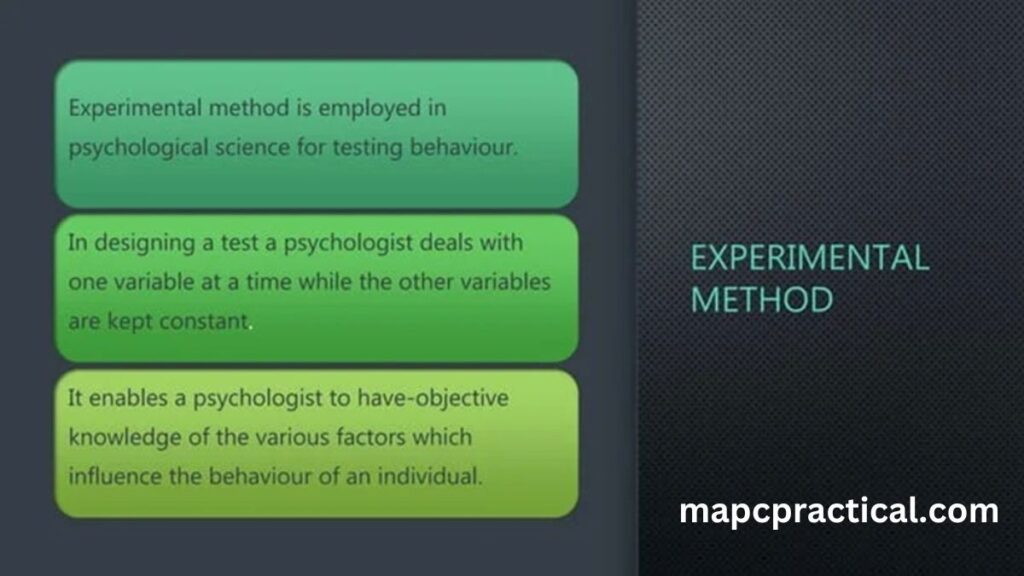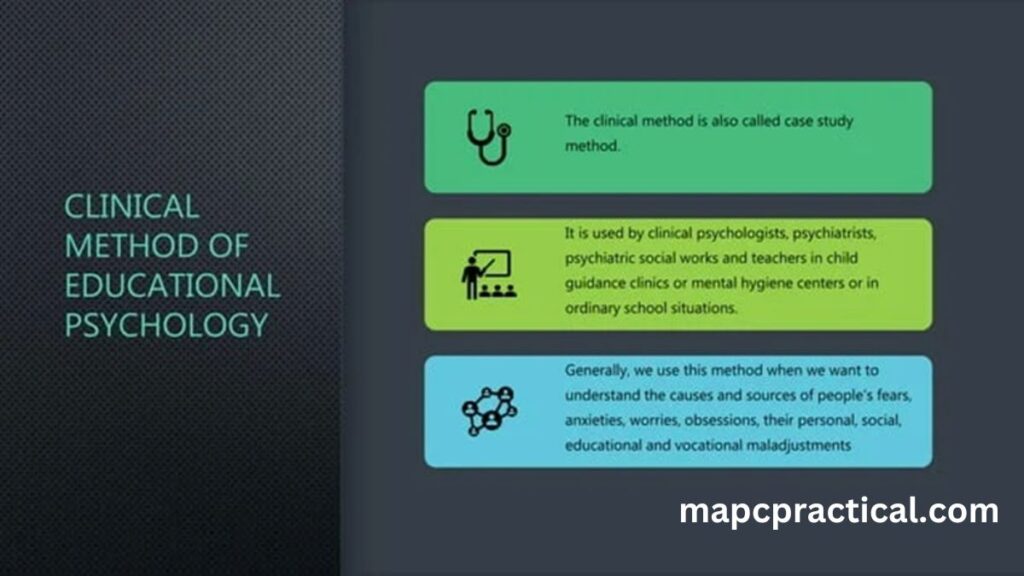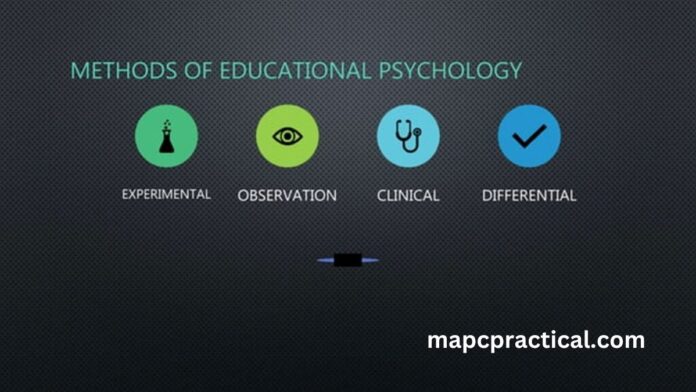The methods of Educational Psychology are various research and investigation techniques used to study human learning, development, and educational processes. These methods provide a systematic approach to understanding the complex interactions between students, teachers, and the educational environment. Each method has its own strengths and limitations and is used in different situations depending on the research question and purpose.
Educational psychology is a branch of psychology that studies the cognitive, affective, and physiological processes involved in learning and instruction. It aims to understand how students learn and how teachers can effectively facilitate learning.
Although there are several ways to record what you see, many depend on the conditions you can observe, your method and your tools. We shall discuss this aspect now.
- One powerful approach for understanding your behaviour is to observe it. For example, you can look within or inward to see what might be troubling you or what could make you happy. This approach is called introspection.
- In some cases, behavioural events can be observed and recorded in natural conditions by someone. This is known as a “naturalistic observation,” or just as a form of “observation.”
- Observation and recording of behavioural events under controlled conditions is known as experimentation.
- In effect, the normative sampling approach to surveying is when they are conducted in real-life settings.
- In case the observation is made through recording a case history, i.e. reconstruction of an individual’s biography, the approach may be termed as the case study or case history method, and if we use psychoanalysis for interpreting the behaviour of a person through the expression of his unconscious behaviour then the method may be termed as the psychoanalytic method.
- If a medical doctor uses case studies and the process of psychotherapy, they should be considered in clinical or medical research.
- If a physical device is used to measure psychological experiences, this may be termed as the psycho-physical method.
These different modes of observation may affect the way that you approach things. You may want to try introspection, naturalistic observation, experimentation, normative survey or field survey (among others), psychoanalytic, clinical and psychophysical methods.
There are several methods of Educational Psychology that educational psychologists use to study learning and instruction, including:
INTROSPECTION METHOD (Methods of Educational Psychology)
This is the oldest method of Educational Psychology for studying animal/human behaviors. The introspection method is a tool that helps you to understand your thoughts, feelings and emotions. It helps you to understand yourself better and how to manage your thoughts, feelings and emotions.
The introspection method was developed by the American psychologist William James in the 1890s. He believed that this technique could be used to help people who have mental health problems or addictions. The introspection method is also known as self-observation or self-study.
In order for this technique to work, you need to keep a diary of what you think about, feel and do during the day. You then need to answer questions about these things in your diary such as what are your thoughts on a certain event? What are your feelings on a certain event? What did you do as a result of these thoughts or feelings? The word ‘introspection’ is made up of two Latin words, ‘in’ and ‘trahere’, meaning to pull out or to draw. Introspection is a process of looking inside yourself – for example, by thinking about your thoughts, feelings and behaviours.
Merits
The observation method of Educational Psychology is a prominent tool in the study of human behavior. It is natural, flexible and economical. The results are reliable and can be verified. If you need to study the developmental characteristics of children’s habits, interests and other personality traits, natural observation would be a good method to choose. For example, the effect a parent’s presence has on a child’s development can be determined by simply observing his development. Likewise, a clinical psychologist may be able to collect the required data about the abnormal behaviour of an individual by observing him in his natural environment during everyday life.
Drawbacks and Limitations
- This Method of Educational Psychology is subjective in the sense that it is based on the interpretation of the observer.
- The observation method is not reliable, as it is subject to inaccuracies with the observer.
- The observation method is not valid, as it provides no further information than what is observed by the observer.
- The observation method is one of the most often used methods in social research. It is a qualitative research technique, wherein the researcher observes the participants and records them in detail for later analysis.
- It can be useful only for the collection of data on the observable behaviour of an individual, but it’s impossible to know what is happening in the mind of others. So you can only make inferences through their external behaviour. Sometimes people can mask their feelings, so it’s hard to tell what they’re really like. These people might seem sober but actually have a dark side.
- Another drawback to the observation method is that the behaviour observed is contingent on when and where it takes place, and on the specific individuals involved. This means that observations are not replicable. As such, each single situation can only occur once.
Experimental Method (Methods of Educational Psychology)

This is a controlled research method of Educational Psychology in which variables are manipulated and the effects on behavior are observed. This method is used to determine cause-and-effect relationships between variables and is considered the most rigorous method for establishing scientific evidence.
It's important to note that experiments can be performed in either the lab or in a controlled environment.
Limitations of the Experimental Method
The experimental method is an important part of the scientific process. It allows researchers to test the validity of their hypothesis and to generate new knowledge about a topic. However, there are some limitations that come with this method.
- The experimental Method cannot be applied to all types of situations. The experimental method is limited by the type of research it can use and by what it can measure.
- Researchers cannot control everything in an experiment. There are many external factors that affect an experiment’s results, such as the participants’ mood or how much they sleep.
- It relies on artificial conditions which can’t be applied in real-life scenarios–such as a lab setting or controlled environment–and may not reflect how humans behave in natural settings, like at home or work.
DIFFERENTIAL METHOD
The differential method is a technique used to identify the cause of an observed difference between two groups. And It is a form of quantitative research that investigates the differences in two groups and then uses those differences to explain the difference in the outcome variable.
Differential method is also named as the normative survey method or the field survey method as the investigator has to go to the field to make his investigations.
Differentiation between experiments and differential methods may appear quite artificial, and it is true that all psychologists will not agree to such an apparently artificial classification scheme. In practice, however, the difference is clear. Experiments are experiments in the sense that they are usually short-term and controlled conditions to measure cause-and-effect relationships. They produce quantitative data, which can be analyzed using statistical tests.
The main tools differential psychologists use are the approaches they use to study people in terms of the differences found within each individual, or amongst different groups of people. There are four major approaches used:
1. Correlation Approach:
The correlation approach is based on the differential method and the observation of two quantities. It is a statistical technique to find out the correlation between two variables. This type of correlation can be used to find out the relationship between two different variables or to see if there is any relationship between them.
For example, in the case of finding the correlation between intelligence and achievement in school, both intelligence and achievement will allow you to measure each individual’s academic achievements. The height and weight of people might be unrelated to their hair color, but we can check with a statistical technique called correlation.
2. Field Survey Approach:
The results of the field survey are analyzed and compared with the data we already know about the population. For example, in ‘studying the individual differences with regard to adjustment patterns or job satisfaction among high school teachers working in government and non-government schools’, the use of the differential method would require
(a) the taking of adequate samples of both categories of teachers,
(b) finding out the adjustment or job satisfaction scores of the teachers included in these groups.
(c) analysing the differences, if any, in the pattern of adjustment or job satisfaction.
3. Longitudinal Approach:
The Longitudinal Approach is all about how an individual changes over a long period of time. For example, Studying the growth and development of infants can help us to learn more about their physical, social and emotional wellbeing – this is because their personality traits change as they grow: However, this type of study would require a substantial portion of time as the researcher has to wait for things to happen naturally.
4. Cross-sectional Approach of Differential Method:
The Cross-sectional Approach is the alternative for studying or discovering the normal trend where instead of studying one or more infants at their successive ages we can take different infants of varying ages for studying them simultaneously to determine the pattern of growth and development at different ages.
In all the approaches I mentioned, the researcher needs to take advantage of statistical methods for analyzing their data and carrying out an interpretation of research findings when it comes to differences between people, groups etc.
CLINICAL METHOD (Methods of Educational Psychology)

The clinical method of psychology is a set of guidelines that are used by psychologists to diagnose and treat mental disorders. The clinical method of psychology has been around for many years and has been the primary way in which psychologists have diagnosed and treated mental disorders.
The guidelines include establishing a diagnosis, gathering information about the person’s condition, classifying the disorder, analyzing the data, coming up with an appropriate treatment plan, implementing the treatment plan and evaluating its effectiveness of it.
Clinical psychology is a puzzle, the pieces of which have to be put together in order to understand them. It includes a clinical approach, and it is also an art and technology. In short, it’s not just about the adjustment problems of the individual – there are other aspects which have to be taken into account for their optimum social integration and well-being.
Method of Diagnosis
Diagnosing issues by simply listening to the individual’s symptoms is not enough. You will have to go through the more general aspects of their situation in order avoid missing out on diagnosis. When trying to understand an individual’s behavior by analyzing personal histories, past events/experiences, the impacts of these events and how the person has reacted to them in the present, their current environment and problems adjusting, it is good to note that their entire personality make-up.
1. Adequate physical check-up: The individual showing a behavioural issue must be checked for necessary medical attention in order to decide whether the problem is of a physical or mental nature. If there are no physical causes for the behaviour in question, it should only then be diagnosed as a subject for psychological treatment.
2. Making out the case history: A psychologist might try to use the “case history technique” to find the clues that led to their patient’s current condition. They explore what life experiences may have been responsible for the type of behaviour they’re exhibiting. In this technique, information is collected from the memories of the individual himself, his parents, the members of his family, his relatives and neighbours. His friends and teachers might also be contacted in order to gather more information about him. Additionally, reports from doctors as well as available information on the individual in question may also be considered. For finding the relevant information, you can use these sources:
(a) Identifying data: This may contain the following: Name, Father’s name, Residential address, Date of birth, Caste (religious), Religion (sometimes), Existence of Exceptional or Abnormal Behavior etc.
(b) Environmental background: This may include information about the family members of the individual and how they interact with each other and more. This may also contain information about their past experiences with the individual being studied, the family’s education level, income levels, their location in the community such as their neighborhood, their children’s friends and activities they engage with at school or on the job.
(c) Developmental history: This may contain the history of the growth and developmental process of the individual in relation to the treatment. behaviour and environmental facilities available from birth onwards, history of his mental and physical health, education and occupation.
(d) History of exceptional/abnormal behaviour: This may contain all the important information related to the behavior, as it’s developed up until this stage.
3. The clinical interview: When interviewing the individual, it is also possible to get more insight into any potential issues.To achieve this, the interviewer may ask appropriate questions and persuade the person to give them honest answers. This can be done by establishing good rapport. For understanding what is going on in their mind, the interviewer may try and use certain tactics. The opportunity to talk about himself may help the interviewee’s mood or provide a helpful venting session. This feedback could be important for determining the root cause of their behaviour.
4. Direct observation of behaviour: Direct observation of how an individual acts in his/her natural work environment can be quite useful in understanding what might cause them to behave that way. Direct observation of an individual at play may provide key insights into their personality and what they need to succeed.
5. Using tests and measuring devices: Some testing and measuring devices can be a great way to find out more about an individual. You could learn about their interests, abilities, attitude, etc. this way and get a better understanding of them.
Method of Treatment
Diagnoses should always be followed by treatment, in order to help our patients as much as possible. For people with behaviour problems, efforts are made to change their behaviour by changing their environment and how they see themselves. This is accomplished through therapy and medication. If these two methods are unsuccessful, drugs may be used to control the symptoms of the problem.
1. Modifying the environmental forces
2. Modifying the individual’s attitude.
Quasi-Experimental Method
This method is similar to the experimental method but lacks some of the controls found in a true experiment. In this method, the researcher manipulates one variable and observes the effects on behavior, but does not have complete control over all other variables.
Correlational Method
This method examines the relationship between two or more variables without manipulating them. Researchers use this method to identify patterns and associations between variables, but cannot establish cause-and-effect relationships.
Case Study Method
This is an in-depth investigation of an individual or a small group of individuals. This method is used to gather detailed information about a person’s experiences and behaviors in a particular situation.
Naturalistic Observation Method (Methods of Educational Psychology)
This method involves observing behavior in natural settings without interfering. This method is used to study behavior in its natural context, without the limitations of controlled laboratory settings.
Instructional Design (Methods of Educational Psychology)
This method of educational psychology involves systematic planning, development, and implementation of instructional materials and methods. This approach involves breaking down the learning process into smaller components and designing instructional materials that are tailored to the specific needs of learners.
Qualitative Research (Methods of Educational Psychology)
This method involves collecting and analyzing non-numeric data, such as words, images, and observations, to gain an understanding of human experiences and behaviors. Qualitative research methods, such as ethnography and case study, are often used to explore complex educational phenomena in depth.
Action Research (Methods of Educational Psychology)
This method involves teachers and researchers collaborating to study their own practices and improve instruction. Action research involves collecting data, analyzing it, and making changes to instructional practices based on the findings.
The best methods of educational psychology
There is no single “best” methods of educational psychology as the choice of method depends on the research question and the variables being studied. Each method has its own strengths and limitations, and different methods are better suited to different types of questions.
For example, experimental and quasi-experimental methods are well-suited to studying cause-and-effect relationships between variables, while qualitative methods such as ethnography and case study are well-suited to exploring complex educational phenomena in depth.
Meta-analysis is a powerful tool for synthesizing the results of multiple studies and providing a comprehensive overview of a body of research.
Action research is a valuable method for teachers and researchers to collaborate and study their own practices, leading to improved instruction and learning outcomes.
Ultimately, the best method will depend on the specific research question and the goals of the study. Educational psychologists often use a combination of methods to gather a comprehensive understanding of the processes involved in learning and instruction.




